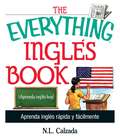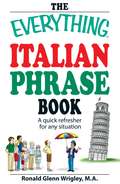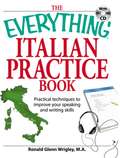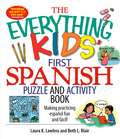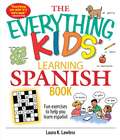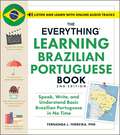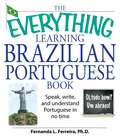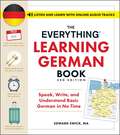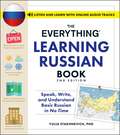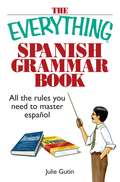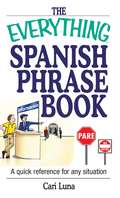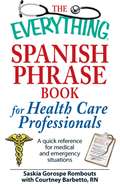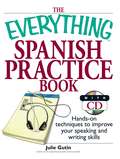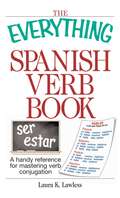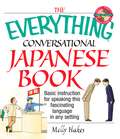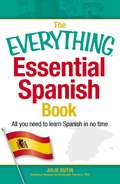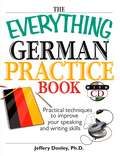- Table View
- List View
The Everything Ingles Book
by N. L. CalzadaAccording to the 2000 census, over one and a half million people in the United States do not speak any English. This number is expected to rise as more states abandon bilingual education and outreach programs in Spanish-speaking communities.The Everything Ingles Book eliminates the stumbling blocks of learning a language with the simplest and most efficient English instruction available. Using what the readers already know about their native language, this book provides lessons in grammar, usage, pronunciation, and vocabulary to help them achieve a proficiency in English and better communicate at home and in the workplace.Practical instruction includes:The parts of speech and proper sentence structureHow to avoid confusion and use English in everyday conversationThe right words and phrases for the right occasionKeys to the many confusing conventions of the English languageCommon phrases and practice lessons designed to build confidenceWritten with the new American in mind, The Everything Ingles Book prepares readers for life in the United States and provides them with the skills necessary to survive and thrive in the English-speaking world.
The Everything Ingles Book
by N. L. CalzadaAccording to the 2000 census, over one and a half million people in the United States do not speak any English. This number is expected to rise as more states abandon bilingual education and outreach programs in Spanish-speaking communities.The Everything Ingles Book eliminates the stumbling blocks of learning a language with the simplest and most efficient English instruction available. Using what the readers already know about their native language, this book provides lessons in grammar, usage, pronunciation, and vocabulary to help them achieve a proficiency in English and better communicate at home and in the workplace.Practical instruction includes:The parts of speech and proper sentence structureHow to avoid confusion and use English in everyday conversationThe right words and phrases for the right occasionKeys to the many confusing conventions of the English languageCommon phrases and practice lessons designed to build confidenceWritten with the new American in mind, The Everything Ingles Book prepares readers for life in the United States and provides them with the skills necessary to survive and thrive in the English-speaking world.
The Everything Ingles Book: Aprende Ingles Rapida Y Facilmente (The Everything®)
by N. L. CalzadaThe Everything® Inglés Book le educara como: Evitar confusión y poder usar el ingles en conversaciones diariasTener las palabras adecuadas para ocasiones como el busco del trabajo y del apartmento, las compras, y mucho másLeer periodics, revistas, libros, y páginas de InternetUsar modismos y expresiones populares en la manera apropriadaLlena de pruebas y ejercicios que la ayuardán retener lo que aprende, The Everything® Inglés Book puede ser su mejor apoyo en la empresa de aprender inglés fácil y divertidamente.
The Everything Italian Phrase Book
by Ronald Glenn WrigleyFor tourists who hope to have a unique, "off the beaten path" experience in Italy, learning a little of the native language is crucial. Just knowing they find the train station (stazione del treno) or say "thank you" (grazie) can relieve some of the stress that traveling can bring. Featuring hundreds of commonly used phrases, this pocket-sized guide provides travellers with the words they need to order dinner, talk on the phone, read street signs and train schedules, shop with confidence, and more. This book even features the basics of Italian grammar and pronunciation as well as common idioms and slang words. Conveniently organized and indexed by category, this quick reference guide is a one-stop guide for quick, practical phrases for any situation.
The Everything Italian Phrase Book: A quick refresher for any situation
by Ronald Glenn WrigleyFor tourists who hope to have a unique, “off the beaten path” experience in Italy, learning a little of the native language is crucial. Just knowing they find the train station (stazione del treno) or say “thank you” (grazie) can relieve some of the stress that traveling can bring. Featuring hundreds of commonly used phrases, this pocket-sized guide provides travellers with the words they need to order dinner, talk on the phone, read street signs and train schedules, shop with confidence, and more. This book even features the basics of Italian grammar and pronunciation as well as common idioms and slang words. Conveniently organized and indexed by category, this quick reference guide is a one-stop guide for quick, practical phrases for any situation.
The Everything Italian Practice Book: Practical techniques to improve your speaking and writing skills
by Ronald Glenn WrigleyA Simon & Schuster eBook. Simon & Schuster has a great book for every reader.
The Everything Kids' First Spanish Puzzle & Activity Book: Make Practicing Espanol Fun And Facil!
by Laura K LawlessMake practicing español fun and fácil!Hola, amigos! Come join in the puzzling fun with The Everything KIDS' First Spanish Puzzle and Activity Book! Filled to the brim with mazes, crosswords, hidden picture puzzles, and matching games, this fun and easy activity book makes learning Spanish straightforward and entertaining!With The Everything KIDS' First Spanish Puzzle and Activity Book, you, the estudiante, will learn basic Spanish speaking skills through puzzles and activities, including words and phrases like:Playtime - ¡Tiempo de jugar!Food and Drink - Comida y bebidaPuzzling People - Personas interesantesMy House - Mi casaWhen I Grow Up - Cuando me hago mayorLoaded with fun activities like this and more, The Everything KIDS' First Spanish Puzzle and Activity Book is your key to learning español--hoy (today)!
The Everything Kids' Learning Spanish Book: Fun Exercises to Help You Learn Español, Fun Exercises to Help You Learn Espanol (Everything® Kids)
by Laura K. LawlessHola, amigos! So, you want to learn Spanish but don't know where to start? Start aquî, with The Everything KIDS' Learning Spanish Book. Packed with sections of fun facts, tips, and silly Spanish phrases, you'll be speaking Spanish before you can say pronto! With this book, you'll learn how to say all of the following in Spanish: Descriptions about yourself and your family Letters, numbers, and punctuation Food and meals Sports and school And some fun phrases to play with Loaded with fåcil and fun lessons to keep you busy for hours, The Everything KIDS' Learning Spanish Book is just the thing to get you to hablar Español hoy!
The Everything Learning Brazilian Portuguese Book, 2nd Edition: Speak, Write, and Understand Basic Brazilian Portuguese in No Time (Everything® Series)
by Fernanda FerreiraDiscover just how easy it is to learn Brazilian Portuguese with this updated edition of The Everything Learning Brazilian Portuguese Book with new online audio so you can quickly access the pronunciation guide and exercises while you&’re reading.The Everything Learning Brazilian Portuguese Book, 2nd Edition makes Brazilian Portuguese a breeze to learn. Whether you are interested in the area or are adding a valuable second language to your resume, you&’ll learn how to: -Understand Portuguese grammar -Improve pronunciation -Ask basic questions in Portuguese -Have basic conversations when traveling, dining out, conduction business, and shopping -And so much more This helpful guide includes links to online audio pronunciation guides, vocabulary lists, and interactive exercises. Packed with dialogue examples, self-tests, and English-to-Portuguese and Portuguese-to-English dictionaries, The Everything Learning Brazilian Portuguese Book, 2nd Edition will have you speaking—and understanding—Portuguese in no time.
The Everything Learning Brazilian Portuguese Book: Speak, Write, and Understand Basic Portuguese in No Time
by Fernanda FerreiraBrazilian Portuguese made easy--and fun!The Everything Learning Brazilian Portuguese Book with CD makes Brazilian Portuguese a breeze to learn! Author Fernanda L. Ferreira, Ph.D., provides you with step-by-step instruction in vocabulary, grammar, and pronunciation. Learn how to:Understand Portuguese grammarImprove pronunciationAsk questions in PortugueseHave basic conversations when traveling, dining out, conducting business, and shopping This helpful guide includes an audio CD with pronunciation guides, extensive vocabulary lists, and interactive exercises. Packed with dialogue examples, self-tests, and English-to-Portuguese and Portuguese-to-English dictionaries, The Everything Learning Brazilian Portuguese Book with CD will have you speaking--and understanding--Portuguese in no time.
The Everything Learning German Book, 3rd Edition: Speak, Write, and Understand Basic German in No Time (Everything® Series)
by Edward SwickDiscover just how easy it is to learn German with this updated edition of The Everything Learning German Book with new online audio so you can quickly access the pronunciation guide and exercises while you&’re reading.It&’s easy to become intimidated by the prospect of learning a foreign language. Now, with online audio, The Everything Learning German Book, 3rd Edition eliminates the stumbling blocks of learning a language to bring you quick and easy success. Whether you are a first-time learner, relearner, or international traveler, you&’ll learn the German language through step-by-step instructions and practical exercises. Cultural information about Germany and the German people makes the guide both simple and entertaining. The pronunciation, parts of speech, and basic vocabulary tips covered in this guide will benefit students, travelers, restaurant-goers, and anyone seeking to learn the language upon which much of English is based. You will learn how to: -Understand verbal etiquette -Order in a restaurant -Ask directions -Communicate efficiently while traveling -Greet strangers properly This edition also includes access to online audio, with pronunciation guides and vocabulary lists. Supplemented by both English-to-German and German-to-English dictionaries, this valuable language reference is the perfect way to learn—or relearn—the language.
The Everything Learning Russian Book, 2nd Edition: Speak, Write, and Understand Basic Russian in No Time (Everything® Series)
by Yulia StakhnevichDiscover just how easy it is to learn Russian with this updated edition of The Everything Learning Russian Book with new online audio so you can quickly access the pronunciation guide and exercises while you&’re reading.Learning a foreign language can be intimidating, but the Everything Series language books can help. Now with online audio, The Everything Learning Russian Book, 2nd Edition makes Russian easy to grasp. Whether you are interested in the area or are adding a valuable second language to your resume, you&’ll learn how to: -Read the Cyrillic alphabet -Understand Russian grammar -Improve pronunciation -Have basic conversations when traveling, dining out, conducting business, and shopping -And so much more This helpful guide includes links to online pronunciation guides, extensive vocabulary lists, and interactive exercises. Packed with dialogue examples, self-tests, and English-to-Russian and Russian-to-English dictionaries, The Everything Learning Russian Book, 2nd Edition will have you speaking—and understanding—Russian in no time.
The Everything Spanish Grammar Book
by Julie GutinThe everything(r) spanish grammar book provides readers with simple instructions for mastering the rules of the Spanish language. Complete with exercises, verb charts, and glossaries, it's the perfect reference for students of any skill level or native speakers who wish to improve their grammar. The Everything(r) Spanish Grammar Book includes: Keys to mastering grammar, syntax, and sentence structure Tips on usage and pronunciation Thorough review of verb constructions Methods to build vocabulary.
The Everything Spanish Grammar Book
by Julie GutinLearning the ins and outs of a new language can be a long and tedious process - especially when it comes to grammar. Yet good grammar is an essential aspect of fluency - one you cannot fake. With The Everything Spanish Grammar Book as your guide, you'll master the grammar essentials of this beautiful language in no time, thanks to expert step-by-step instruction.Invaluable tools include:Verb tables for fast sentence structuringChapter-by-chapter linguistic breakdowns for quick referenceReinforcing exercises at the end of each sectionUsage and pronunciation tips for speakers of all levelsEnglish-Spanish and Spanish-English dictionaries to give you the right wordComplete review of verb constructionVocabulary-building methodsSpeak like a native with The Everything Spanish Grammar Book - your key to understanding the grammar, syntax, and sentence structure of the Spanish language.
The Everything Spanish Grammar Book: All The Rules You Need To Master Espanol
by Julie GutinLearning the ins and outs of a new language can be a long and tedious process - especially when it comes to grammar. Yet good grammar is an essential aspect of fluency - one you cannot fake. With The Everything Spanish Grammar Book as your guide, you'll master the grammar essentials of this beautiful language in no time, thanks to expert step-by-step instruction.Invaluable tools include:Verb tables for fast sentence structuringChapter-by-chapter linguistic breakdowns for quick referenceReinforcing exercises at the end of each sectionUsage and pronunciation tips for speakers of all levelsEnglish-Spanish and Spanish-English dictionaries to give you the right wordComplete review of verb constructionVocabulary-building methodsSpeak like a native with The Everything Spanish Grammar Book - your key to understanding the grammar, syntax, and sentence structure of the Spanish language.
The Everything Spanish Phrase Book (The Everything®)
by Cari LunaWith the increase in travel to Spanish-speaking countries as well as the rise in the Latino population in the United States, a growing number of people are in need of a quick reference to help them communicate. Sadly, most Spanish reference books contain outdated phrases organized in a manner that make it difficult to find the right words for the right situation. The Everything Spanish Phrase Book remedies these shortcomings with a practical, real-world approach to language learning that is both quick and easy to use.From ordering dinner and asking for directions to working and communicating in Latino communities, this handy guide provides readers with all they need as ellos hablan español in any setting.Organized by situation, The Everything Spanish Phrase Book contains the right words for:Traveling and making reservationsDining and shoppingSpeaking Spanish in a business settingWorking with the Latino communityFully indexed and complete with a pronunciation guide and helpful dictionaries, The Everything Spanish Phrase Book is the ideal resource for business or pleasure.
The Everything Spanish Phrase Book for Health Care Professionals
by Saskia Gorospe Rombouts Courtney BarbettoThis book is the perfect guide for doctors, nurses, and other health care personnel who treat Hispanic patients who speak little or no English. It includes more than 1,400 useful lists of phrases and words that are most likely to be used in a medical setting. Readers can flip quickly to the appropriate section for help in asking and answering questions. This handy reference helps medical and administrative staff to: Make appointments Collect medical history and insurance information Describe procedures Ask about symptoms and pain Reassure and comfort patients This pocket-sized guide even features the basics of Spanish grammar and punctuation. Complete with Spanish and English glossaries, and is all health care workers need to communicate effectively with their Hispanic patients and family members.
The Everything Spanish Phrase Book for Health Care Professionals
by Saskia Gorospe Rombouts Courtney BarbettoThis book is the perfect guide for doctors, nurses, and other health care personnel who treat Hispanic patients who speak little or no English. It includes more than 1,400 useful lists of phrases and words that are most likely to be used in a medical setting. Readers can flip quickly to the appropriate section for help in asking and answering questions. This handy reference helps medical and administrative staff to: Make appointments Collect medical history and insurance information Describe procedures Ask about symptoms and pain Reassure and comfort patients This pocket-sized guide even features the basics of Spanish grammar and punctuation. Complete with Spanish and English glossaries, and is all health care workers need to communicate effectively with their Hispanic patients and family members.
The Everything Spanish Phrase Book for Health Care Professionals: A quick reference for medical and emergency situations
by Saskia Gorospe RomboutsThis book is the perfect guide for doctors, nurses, and other health care personnel who treat Hispanic patients who speak little or no English. It includes more than 1,400 useful lists of phrases and words that are most likely to be used in a medical setting. Readers can flip quickly to the appropriate section for help in asking and answering questions. This handy reference helps medical and administrative staff to: Make appointments Collect medical history and insurance informationDescribe proceduresAsk about symptoms and pain Reassure and comfort patients This pocket-sized guide even features the basics of Spanish grammar and punctuation. Complete with Spanish and English glossaries, and is all health care workers need to communicate effectively with their Hispanic patients and family members.
The Everything Spanish Practice Book: Hands-on Techniques to Improve Your Speaking And Writing Skills (The Everything®)
by Julie Gutin¿Habla espanol?Are you ready to take your basic Spanish skills to the next level? Have you gotten all you can from your instructional textbooks? Do you like to learn in creative and fun ways?With exciting audio narrated by Con Salsa Radio Host Peter Martinez and with over 200 exercises, The Everything Spanish Practice Book with CD has everything needed to master the Spanish language. Ideal for the beginner and intermediate speaker alike, this fun and easy-to-follow guide is a complete learning experience.With emphasis on:Proper Spanish grammar and usageVocabulary building techniquesInstructional keys to pronunciationComprehension and conversation skillsWriting clearly and effectivelyThe Everything Spanish Practice Book with CD is the ultimate resource for improving - and perfecting! - your Spanish.
The Everything Spanish Verb Book: A Handy Reference For Mastering Verb Conjugation (Everything®)
by Laura K LawlessA Simon & Schuster eBook. Simon & Schuster has a great book for every reader.
The Everything® Conversational Japanese Book
by Molly HakesWith the globalization of business and the advancement of international trade, learning a foreign language is quickly becoming more and more essential for advancement in today's world. The Everything Conversational Japanese Book, with a companion CD, teaches you how to master one of the most predominant languages in business and secure you an unparalleled edge in the job market. Understanding cultural references, learning correct pronunciation, and giving an effective introduction are all a cinch with this all-inclusive guide. Featuring exercises and quizzes at the end of each chapter, The Everything Conversational Japanese Book prepares you for any situation and enables you to carry on a basic conversation in very little time. The Everything Conversational Japanese Book helps you: •Use appropriate tone •Master vocabulary •Communicate in a business or casual setting •Respond effectively •Understand and appreciate Japanese culture Whether you're just visiting Japan or wish to further your career opportunities by learning another language, The Everything Conversational Japanese Book and companion CD is your jumpstart to speaking Japanese quickly and with confidence.
The Everything® Essential Spanish Book
by Julie GutinLearning Spanish can be easy and fun! Hola! If you've always wanted to learn Spanish, here's a quick and easy way to get started. Whether you're planning a vacation in Mexico or adding a valuable second language to your resume, The Everything Essential Spanish Book will help you order the right dish in a restaurant, answer customer's questions, or converse with locals when traveling. With easy-to-follow instructions and simple explanations, this portable guide covers the most important Spanish basics, including: The Spanish alphabet and translation Greetings and conversation starters Common questions and answers Verb tenses and sentence structure Don't just learn to repeat words and key phrases--learn to understand them on your own terms and at your own speed. The simple step-by-step approach and lively examples will have you speaking--and understanding--Spanish in no time!
The Everything® German Practice Book
by Jeffery DonleyPractice your German-speaking skills with this innovative practice book and audio CD. Whether you're a beginner or intermediate speaker, The Everything German Practice Book with CD has everything you need to take your proficiency to the next level.
The Everything® Learning Brazilian Portuguese Book
by Fernanda L. FerreiraThe Everything[Registered] Learning Brazilian Portuguese Book with CD makes Brazilian Portuguese a breeze to learn! Author Fernanda L. Ferreira, Ph. D. , provides you with step-by-step instruction in vocabulary, grammar, and pronunciation. Learn how to: Understand Portuguese grammar, Improve pronunciation, Ask questions in Portuguese, Have basic conversations when traveling, dining out, conducting business, and shopping.
